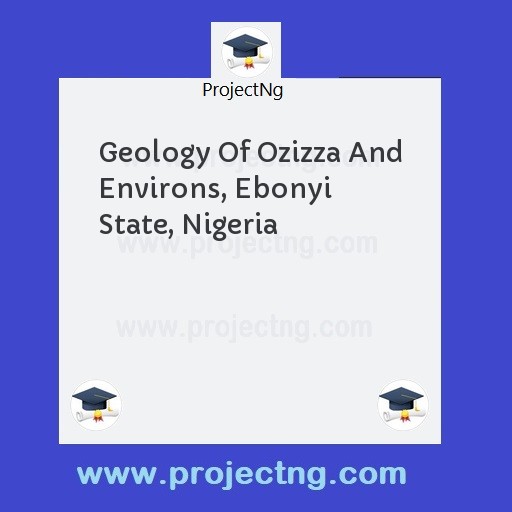Geology Of Ozizza And Environs, Ebonyi State, Nigeria
Geology Project Topics
Get the Complete Project Materials Now! »
ABSTRACT
Cretaceous sediments outcropped extensively in the Afikpo sedimentary basins. Detailed geological mapping of Ozizza and environs was undertaken in order to give a detail descriptions of the lithological features, stratigraphic relationships and contacts, sedimentary structures, and their paleontological contents. Sieve analysis, hydrological and palynological analyses of selected outcrop samples were carried out in order to reconstruct the depositional history of the sediments in the area and their provenance, assess the age of sediments and establish their paleoenvironments of deposition, and evaluate the hydrocarbon source rock potential and the degree of thermal maturation. Two main lithological units were encountered, which include sandstone and shale. Result from thesieve analysis indicates that the sandstones in the study areawere mostly deposited in a beach and fluvial settings. Physicochemical results from heavy metals analysis indicated significant concentration of sodium (Na) in the water samples. Results from the palynological investigation revealed a Late Campanian to Earliest Maastrichtian for the sediments, with the following index sporomorphs assemblage:Cingulatisporites ornatus, Zlivisporis blanensis, Distaverrusporites simplex, Longapertites marginatus, Constructipollenites ineffectus, Monocolpites marginatus, Echitriporites trianguliformis,, Buttinia andreevi, and Retidiporites magdalenensis. Environmentally significant palynomorphs indicated that the sediments in the study area were depositedin a marginal marine/ nearshore brackishwater environments of deposition, with minor marine influence. Kerogen analysis shows that all the sediments were mostly dominated by phytoclasts followed by opaque debris and AOM, giving rise to mostly type III kerogen, which are generally immature but have potential to generate gas.
TABLE OF CONTENTS
TITLE PAGE i
APPROVAL PAGE ii
DEDICATION iii
ACKNOWLEDGEMENTS iv
ABSTRACT v
TABLE OF CONTENTS vi
LIST OF FIGURES vii
CHAPTER ONE: INTRODUCTION 13
1.1 LOCATION AND ACCESSIBILITY 13
1.2 GEOGRAPHY 14
1.2.1 CLIMATE 15
1.2.2 VEGETATION 17
1.2.3 THE PEOPLE 19
1.3 LITERATURE REVIEW 19
1.4 SCOPE OF WORK AND OBJECTIVES OF PRESENT STUDY 20
1.5 STUDY METHODOLOGY 21
1.5.1 PRELIMINARY STUDIES 22
1.5.2 FIELD STUDIES 22
1.5.3 LABORATORY ANALYSES 22
CHAPTER TWO: GENERAL GEOLOGIC SETTING 24
2.1 GEOMORPHOLOGY 26
2.1.1 TOPOGRAPHY 27
2.1.2 DRAINAGE 29
2.2 REGIONAL GEOLOGIC SETTING 32
2.2.1 TECTONIC SETTING 33
2.2.2 STRATIGRAPHIC SETTING 34
2.2.3 EVOLUTION OF THE BENUE TROUGH 34
CHAPTER THREE: LITHOSTRATIGRAPHY 35
3.1 DESCRIPTION OF STRATIGRAPHIC SECTIONS
3.1.1 NDIBE BEACH SECTION 36
3.1.2 EHUGBO TECHNICAL COLLEGE SECTION 38
3.1.3 SCOTT SPRING NDIBE SECTION 39
3.1.4 UZOEZEALI SECTION 41
3.1.5 NNEMOGWU HILL SITE 42
3.1.6 Mcgregor section 43
3.1.7 AMURO/MGBOM SECONDARY SCHOOL SECTION 44
CHAPTER FOUR: LABORATORY ANALYSES 41
4.1 SIEVE ANALYSIS 41
4.1.1 METHODOLOGY 70
4.1.2 RESULTS 71
4.2 HYDROGEOLOGICAL ANALYSIS 72
4.2.1 METHODOLOGY 73
4.2.1 RESULTS 73
4.2.2 PALYNOLOGICAL ANALYSIS 76
4.3 METHODOLOGY 79
4.3.1 RESULTS
4.3.2 KEROGEN ANALYSIS 79
4.4 METHODOLOGY 80
4.4.1 RESULTS 82
CHAPTER FIVE: INTERPRETATION OF RESULTS AND DISCUSSIONS
5.1 SIEVE INTERPRETATION 87
5.1.1 HYDROGEOLOGICAL INTERPRETATION 89
5.2 PALYNOLOGICAL INTERPRETATION 89
5.2.1 AGE ASSESSMENT/ CORRELATION 90
5.2.2 PALEOENVIRONMENTS OF DEPOSITION 91
CHAPTER SIX: SUMMARY AND CONCLUSIONS 92
REFERENCES 93
APPENDIX
CHAPTER ONE:
INTRODUCTION
1.1 LOCATION AND ACCESSIBILITY
The study area is located along Afikpo-Okigwe axis and bounded by latitudes 5° 51IN and 6°03IN and longitudes 007º51IE and 8° 06I E (Fig. 1), and with an area extent of about 74 sqkm (Fig. 1). The study area is bounded on the north by Afikpo, on the south by Eberiba and on the west by Amasiri town.It covers area such as, Anofia Nkanu, Amangbala and Ebom in Ebonyi State, South Eastern Nigeria. Access to the area is through the roughly east-west Afikpo-Okigwe road, which connects the Okposi-Amaseri-Amoso road at Amasiri. On the outskirts of Afikpo town, this road connects with the Northbound Abakaliki road passing through Akpoha and Abomege. The eastern side of the study area is accessible through the Abomege-Ugep road, which passes through the Cross River at Itigidi to Ugep and Calabar towards the southern part of the study area. Other minor roads link the smaller interior villages from these major roads. The major roads are tarred while the minor roads are untarred and may not be accessible during the rainy season.
1.2 GEOGRAPHY
1.2.1 CLIMATE
The study area experiences two seasons, the rainy and dry seasons. There is however, a short break of one to three times, usually referred to as “August break”. The hottest months are usually between October and March.
Rainfall in this area is evenly distributed and is high, about 190 cm per annum, and 95 % of this takes place between the months of April and October (Ibe and Okeke, 1974). The rate of evaporation from the open surface water as estimated by Mirenenko (1966) is 2cm per annum.
Fig. 1: Location and accessibility map showing the drainage system of study area.
The mapped area falls within the zone of 27o-30o of annual temperature. The climate of this area is classified as a tropical wet and dry savannah
Be the First to Share On Social

Enjoying our content?
Don't miss out on new videos! Subscribe to our YouTube channel for more awesome content.
Subscribe Now!













